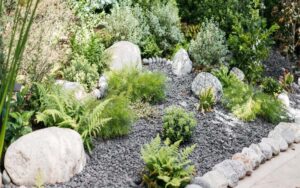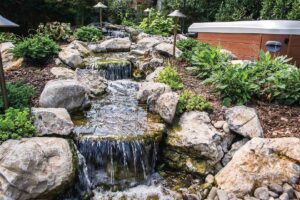THERAPEUTIC GARDEN: A MODEL FOR HEALING SPACES
Dr. M. Lakshmi Madhuri
Assistant Professor
Dept. of Horticulture
N.S. College of Horticultural Sciences
Markapuram
Dr. Lakshmaiah Kathari
Assistant Professor
Dept. of Horticulture
N.S. College of Horticultural Sciences, Markapuram
Dr.R.V.S.K.Reddy
Associate Dean, N.S.Agricultural College, Markapur, Andhra Pradesh
- A Therapeutic Garden or healing garden is an outdoor garden space that has been specifically designed to promote a healing environment, receive mental and physical health benefits and increase well-being. The focus of the therapeutic gardens is primarily on incorporating plants and friendly wildlife into the space near to hospitals and healthcare centers for the better health outcomes of the peoples.
HISTORY:
- “The idea of healing garden is both ancient and modern”
- Persian garden, the Japanese Zen garden and the Monastic Cloister gardens are some of examples of a healing environment which appeared throughout history in different parts of the world.
- The Greeks created healing temples for their gods. The temple for the god Aesclepius (god of healing) was built in pastoral settings with mineral springs, bathing pools, gymnasiums, and healing gardens. where people would come to worship, lodge, recreate, and heal.
- In the 19th century, Dr. Benjamin Rush was first to document the positive effect working in the garden had on individuals with mental illness.
- In US, horticultural therapy blossomed after World War II, with homecoming soldiers in need of restorative therapy.
- Friends Asylum, the first known example of psychiatric hospitals using gardening activities opened in 1813 in Philadelphia.
Benefits of therapeutic gardening:
Psychosocial benefits:
Reduced stress and anxiety, increased self-esteem, decreased social isolation, increased social engagement and participation, sense of pride in work, improved overall sense of well being, increased overall mood and decreased feelings of depression
Cognitive benefits:
Improved concentration, Memory activation and increased attention span
Physical benefits:
Physical fitness and health, reduced pain, prevention of fractures and increased bone density and improved immune response
Types of Therapeutic Gardens:
Not every therapeutic garden design has the same goal in mind. Designs may incorporate either an active, hands-on approach or a more passive, contemplative environment. The International Journal of Architectural Research classifies therapeutic gardens into the following categories:
- Healing, 2. Enabling, 3. Meditative, 4. Rehabilitative, 5. Restorative, 6. Memory and 7. Sensory gardens.
- Healing garden:
A healing garden uses horticultural therapy to enhance the overall healing process. These gardens incorporate fragrant and colorful plants and water features that encourage physical, mental, and emotional healing in both patients and visitors. Some facilities may employ a horticulturist specializing in garden therapy. The therapist assists patients in meeting healing goals by participating in garden activities. In addition, the therapist will document the impact of planned activities on the healing process. However, not all healing gardens employ planned activities. Instead, some simply allow nature to take its course as patients are exposed to the sensory stimulus of the garden setting. For example, a healing garden can help Alzheimer’s patients and those suffering from similar brain function disorders. Pleasant memories are stimulated through all five senses increasing the patient’s overall wellbeing.
- Enabling Gardens:
Enabling therapeutic gardens focus more on the physical recovery and condition of patients. An enabling garden may even include professional training for work in the horticultural industry after recovery. Physical gardening activities improve confidence and restore mental balance as well as provide strength and coordination. Routine garden tasks instill a feeling of usefulness and accomplishment after a severe injury or traumatic event.
- Meditative Gardens:
Meditative gardens often contain therapeutic garden plants that are beautiful and attract birds, butterflies, or other peaceful wildlife for the observant visitor to enjoy. These gardens encourage quiet, stress-reducing environments where difficult life events can be processed at leisure. Meditative gardens are designed to rejuvenate and restore emotional and psychological balance. Carefully planned paths and solitary alcoves supply privacy for those in need of undisturbed meditation. Such gardens are beneficial for veterans suffering from PTSD (Post Traumatic Stress Disorder) or victims of violence or loss.
- Rehabilitative Gardens:
Rehabilitative gardens are unique in that they are not only for the healing of the gardeners but also for the environment. In areas where natural or man-made factors have damaged soil or created potential erosion issues, a rehabilitative garden can help bring communities together for both social and environmental healing. Therapeutic garden plants can include natural species as well as more traditional garden occupants. Rehabilitative gardens bring nature and humans together in unique communion and harmony with their natural surroundings. Gardening creates a greater sense of unity for those who cooperate for the success of the whole.
- Restorative Gardens:
Restorative gardens are planned around the idea of relieving stress and restoring calm to shattered nerves after traumatic events. Those suffering from PTSD (Post Traumatic Stress Disorder) can find a place of quiet, undisturbed sanctuary in a restorative healing garden. Some healing benefits of restorative or other horticultural therapy includes Increased muscle strength, improved coordination, improved balance, greater endurance, greater Problem solving skills and increased social skills.
- Memory Gardens:
Memory gardens are constructed in areas like adult day centers, memory care units and dementia residences. It is mainly used for memory stimulation and stress management, decreased agitation and anxiety.
- Sensory Gardens:
Sensory gardens are mainly established in the areas like outpatient clinics, schools and dementia residences which stimulates or calms senses.
Principles of Therapeutic garden:
- Sustainability:
The garden’s success is very much dependent upon the staff’s understanding of the design. By recognizing the different elements and their functions and use, staff will feel more empowered to develop activities that encourage the use of the gardens.
- Orientation:
Locate gardens where they can be easily viewed from inside to encourage people with dementia to venture out. Simple path system. Ensure the entry/exit is obvious, clearly marked and open at all times to ensure that users do not feel trapped.
- Accessibility:
Ensure garden accessible with people by removing the physical and mental barriers. Ensure there is plenty of shade.
- Socialisation:
Enhance the quality of life. Include interactive garden features such as men’s shed, raised garden beds, flower gardens, bird feeders and bird baths. Include elements that encourage interaction between family members.
- Meaningful activity:
Include garden features that require daily interaction such as a bird feeder, herb garden, aviary or fish pond.
Plants used in therapeutic gardens:
The plants selected should be non-toxic and should enhance the sense of smell to relax and reminisce
Scented flowers:
Lavendula angustifolia, Rosa damascena, Stock (Mathiola incana L.), Blue bottle (Centaurea cyanus L.)
Scented climbers:
Honey suckle, Madhvilata, Potato vine, Star Jasmine, Rangoon creeper, Bower vine
Scented shrubs:
Gardenia jasminoides, Cestrum diurnum , Murraya exotica, Jasminum sambac, Cestrum nocturnum
Anti stress herbs:
Lavandula angustifolia, Ocimum sanctum, Passion flower, Rosemarinus officinalis, Balm mint (Melissa officinalis), Chamomile (Matricaria recutita), Piper methusticum, Valeriana officinalis
Trees for shade: Alstonia scolaris, Pongamia pinnata, Azadirachta indica
Sense of taste: Solanum lycopersicum, Fragaria x ananassa, Thymus vulgaris, Lavenula officinalis, Rosa damascene, Mathiola incana L., Centaurea cyanus L.,Tropaeolum mjus, Ornamaental Plum, Ornamaental Peaches, Ornamaental Cherry
Sense of sound of to clam the nerves: Bamboos, Magnolia grandiflora, Peltophorum ferruginium, Platanus orientalis, Musa paradisiaca Sweet corn,
Attract buzzing bees: Lavendula officinalis

















